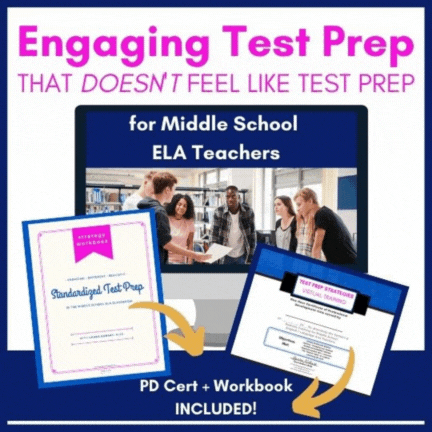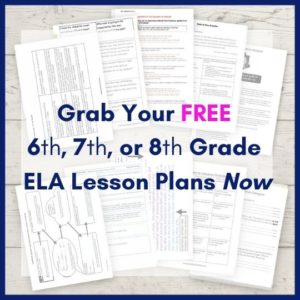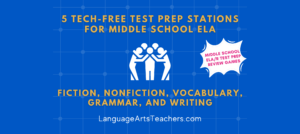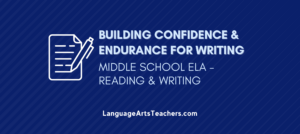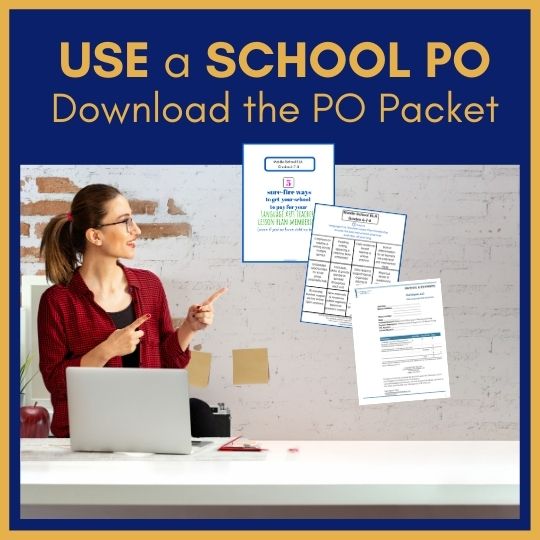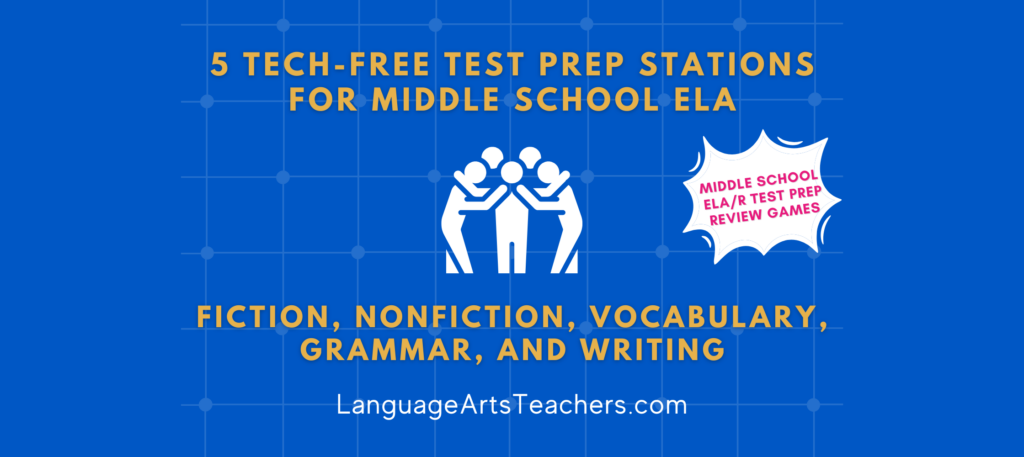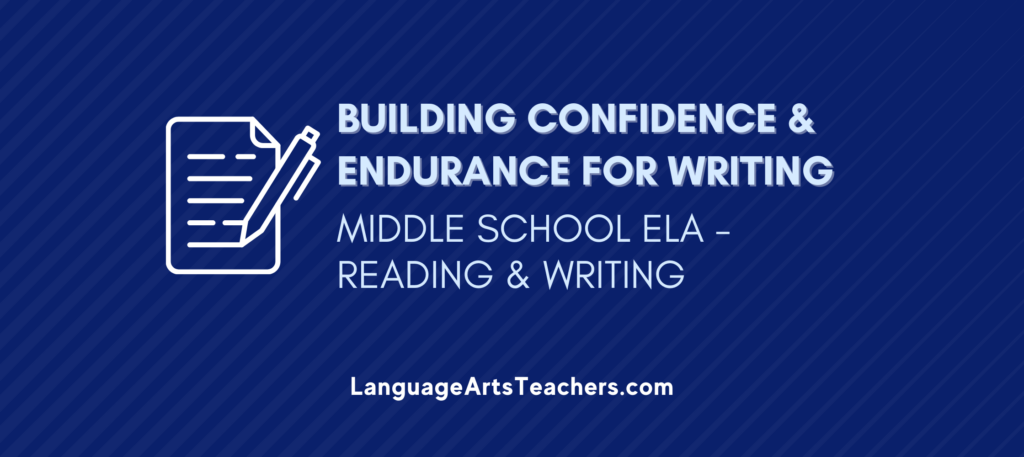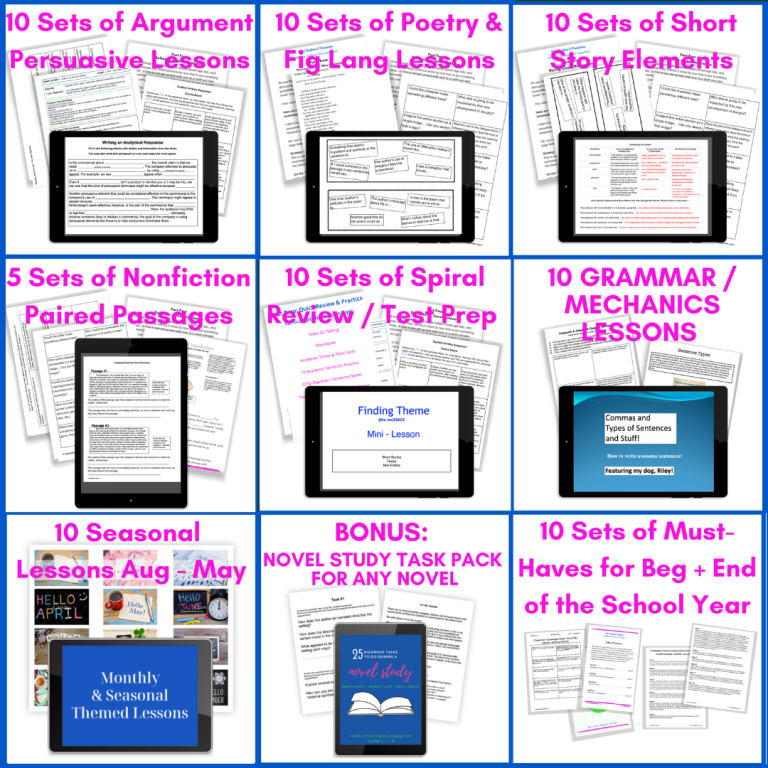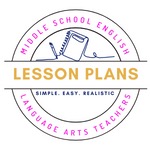Welcome, Middle School ELA teachers! 📚✨ I’m assuming you’re here because you’re looking to simplify the process of planning a narrative reading and writing unit.
Welp, you’re in the right place! Let’s navigate this journey together, armed with practical strategies to streamline your planning process, saving you time and reducing overwhelm.
Narrative reading and writing go several steps further than a typical fiction or short story unit, getting into the creative craft of storytelling.
Here are the same clear, simple steps I use to create my own Middle School Narrative Units which will empower you to create an engaging and effective unit for your students, too! 🚀💡
Step 1: Set the Stage with Bell-to-Bell Planning
- Determine the learning objectives: Define what you want your students to know and be able to do by the end of the unit.
- Chunk the unit: Break down the unit into manageable chunks, outlining the key concepts and skills to be covered each day. My biggest tip here is to plan less than you think because the lessons will more than likely take longer to teach (you know, classroom disruptions, last-minute fire drills, etc). Plus, I like to keep Fridays kind of “open” as buffer time to allow for overflow from Monday – Thursday.
- Create engaging hooks: Plan attention-grabbing bell ringers (aka warm ups or “do now’s”) to start class. These could be in the form of quotes or images that spark quick-writes and discussions to introduce each lesson and to engage students right away. Each day’s lesson in my Narrative Units contains a “bell ringer” that either hooks the students into that day’s lesson, or that serves as a pre-teaching or reviewing opportunity before the official lesson of the day begins.
- Scaffold instruction: Provide clear, step-by-step instructions and support to help students navigate complex concepts and tasks.
- Assess understanding: Incorporate formative assessments throughout the unit to gauge student progress and adjust instruction as needed.
Step 2: Unleash the Power of Mentor Texts with Ready-Made Units
- Select diverse mentor texts: Choose a variety of texts that represent different genres, styles, and cultural perspectives to expose students to a range of storytelling techniques. Quick favorites that I LOVE using are picture books—yes, picture book!–for Middle School ELA mentor texts → Check out what I do and how I do it here.
- Analyze key elements: Break down each mentor text to identify the narrative elements at play, such as plot structure, character development, and setting.
- Model annotation: Demonstrate how to annotate texts effectively, encouraging students to highlight key passages, make notes in the margins, and ask questions. → I’ve got some specific how-to’s for what that looks like and how I teach annotating right here.
- Facilitate discussions: Lead discussions about the mentor texts, guiding students to analyze and interpret the author’s choices and techniques (why certain words were used instead of other words… what students notice about sentence structure or figurative language, etc.)
- Provide guided practice: Scaffold activities that allow students to practice applying the strategies and techniques they’ve learned from the mentor texts to their own writing.
Step 3: Plot a Course with Structured Lesson Plans
- Introduce plot elements: Teach students about the essential components of plot—exposition, rising action, climax, falling action, and resolution—using clear explanations and examples.
- Analyze story structure: Break down examples of narrative arcs from mentor texts, guiding students to identify each plot element and trace the progression of the story.
- Brainstorm story ideas: Lead brainstorming sessions to generate potential plot ideas, encouraging students to draw from personal experiences, observations, or existing stories for inspiration.
- Develop story outlines: Guide students through the process of outlining their stories, helping them organize their ideas and plan the sequence of events.
- Provide feedback: Offer constructive feedback on students’ story outlines, focusing on strengths and areas for improvement, and encouraging revision and refinement.
Step 4: Character Development Made Easy
- Create character profiles: Lead students in creating detailed profiles for their main characters, including traits, motivations, goals, and flaws. This can be fun! Let them “play” by mocking-up their characters in a visual way, whether digitally or hand-sketched.
- Explore character relationships: Encourage students to consider how their characters interact with others in the story, shaping conflicts, alliances, and dynamics.
- Conduct character interviews: Have students “interview” their characters to delve deeper into their personalities, beliefs, and backstories.
- Use character-building activities: Incorporate activities, such as role-playing, character diaries, or character sketches to deepen students’ understanding of their characters.
- Revise and refine: Encourage students to revisit their character profiles throughout the writing process, refining their characters’ traits and motivations as the story evolves.
Step 5: Setting the Scene with Engaging Resources
- Create sensory descriptions: Teach students to use vivid sensory details—sight, sound, smell, taste, and touch—to bring their settings to life for readers.
- Utilize visual aids: Provide images, maps, or videos to inspire students’ descriptions of settings and help them visualize their story worlds.
- Incorporate research: Encourage students to research real-world locations or historical periods to add authenticity and depth to their settings.
- Foster creativity: Challenge students to invent imaginative settings, pushing the boundaries of reality to create unique and immersive worlds.
- Revise for vividness: Prompt students to revisit their setting descriptions during the revision process, focusing on enhancing clarity, specificity, and evocativeness.
Step 6: Conquer Conflict with Teacher-Friendly Strategies
- Identify central conflicts: Help students pinpoint the central conflicts driving their stories, whether they’re internal struggles, interpersonal conflicts, or external obstacles.
- Build tension: Teach students techniques for building suspense and tension, such as foreshadowing, cliffhangers, and pacing.
- Create obstacles: Encourage students to introduce obstacles and challenges that test their characters’ resolve and drive the plot forward.
- Raise the stakes: Guide students in escalating the consequences of their characters’ actions, heightening the tension and urgency of the narrative.
- Resolve conflicts effectively: Model how to resolve conflicts in a satisfying and meaningful way, emphasizing character growth, resolution, or acceptance. Two social-emotional “games” (they’re not games, but my students refer to them as games) I like to use in the classroom are the 52 Essential Social Dilemmas found here and the 52 Essential Coping Skills found right here. → Side note: When students use these tools for their characters, they’re actually learning some excellent skills to use for themselves in real life, too. Win-win for sure.
Step 7: Theme-tastic Adventures with Rigorous Instruction
- Identify themes: Explore the themes present in mentor texts and help students identify the overarching themes in their own narratives.
- Analyze thematic elements: Guide students in analyzing how characters, plot events, and symbols contribute to the development of themes in a story.
- Connect themes to life: Facilitate discussions about the real-world relevance of thematic messages, encouraging students to make connections to their own lives and experiences.
- Foster critical thinking: Prompt students to consider different perspectives on thematic issues, challenging them to think critically and empathetically.
- Reflect on theme development: Encourage students to reflect on the evolution of themes in their narratives, considering how their ideas and perspectives have deepened over the course of the unit.
Step 8: Revise, Rewrite, Repeat with Time-Saving Tools
- Establish revision criteria: Provide students with clear criteria for revision, focusing on elements such as plot coherence, character development, descriptive language, and thematic depth.
- Peer editing workshops: Facilitate peer editing workshops where students exchange feedback on each other’s drafts, using structured protocols and guidelines.
- Utilize self-assessment tools: Encourage students to use self-assessment tools, such as rubrics or checklists, to evaluate their own writing and set goals for improvement.
- Model revision strategies: Demonstrate revision strategies and techniques through mini-lessons or guided writing exercises, showing students how to refine and polish their work effectively.
- Celebrate progress: Recognize and celebrate students’ growth and achievements throughout the revision process, fostering a positive and supportive writing community.
For more insights into organizing your units, planning your year, and engaging students in your Middle School ELA Classroom, get your free ticket to the MSELA Summit which is the annual back-to-school virtual conference specifically designed for Middle School ELA Teachers.
Click Here for the Dates + Details!



